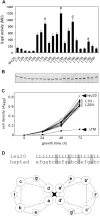The interface of a membrane-spanning leucine zipper mapped by asparagine-scanning mutagenesis
- PMID: 14739334
- PMCID: PMC2286708
- DOI: 10.1110/ps.03357404
The interface of a membrane-spanning leucine zipper mapped by asparagine-scanning mutagenesis
Abstract
An oligo-leucine sequence has previously been shown to function as an artificial transmembrane segment that efficiently self-assembles in membranes and in detergent solution. Here, a novel technique, asparagine-scanning mutagenesis, was applied to probe the interface of the self-assembled oligo-leucine domain. This novel approach identifies interfacial residues whose exchange to asparagine leads to enhanced self-interaction of transmembrane helices by interhelical hydrogen bond formation. As analyzed by the ToxR system in membranes, the interface formed by the oligo-leucine domain is based on a leucine-zipper-like heptad repeat pattern of amino acids. In general, the strongest impacts on self-assembly were seen with asparagines located around the center of the sequence, indicating that interaction is be more efficient here than at the termini of the transmembrane domains.
Figures


References
-
- Bowie, J.U. 1997. Helix packing in membrane proteins. J. Mol. Biol. 272 780–789. - PubMed
-
- Chen, J. and Kendall, D.A. 1995. Artificial transmembrane segments. J. Biol. Chem. 270 14115–14122. - PubMed
-
- Choma, C., Gratkowski, H., Lear, J.D., and DeGrado, W.F. 2000. Asparagine-mediated self-association of a model transmembrane helix. Nature Struct. Biol. 7 161–166. - PubMed
Publication types
MeSH terms
Substances
LinkOut - more resources
Full Text Sources
Research Materials

